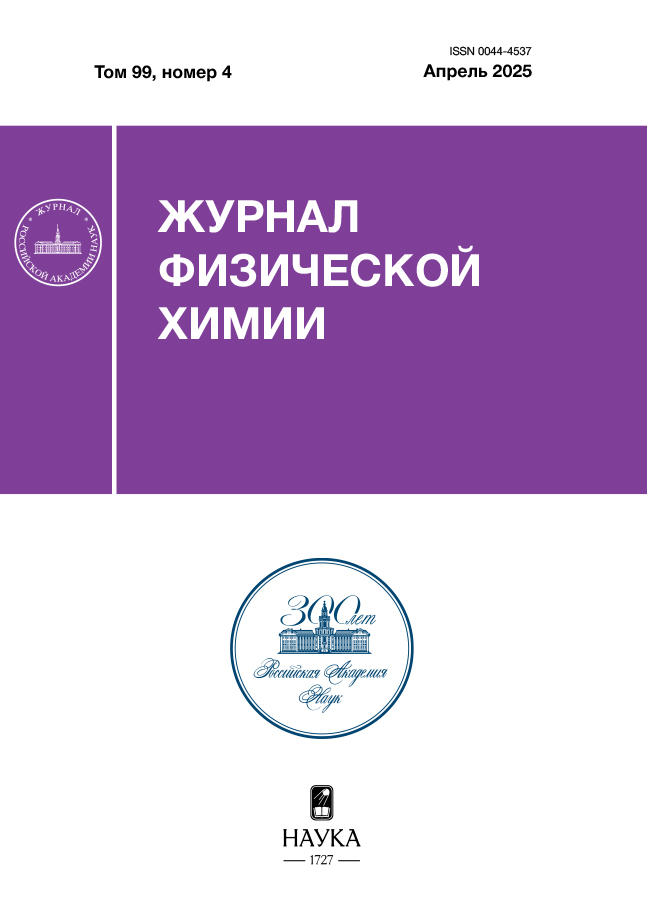Объемные свойства системы вода ‒ мочевина ‒ хлорид холина
- Авторы: Калинюк Д.А.1, Селезенева Е.А.2, Юмаков Д.И.2, Косова Г.Н.2,3
-
Учреждения:
- Московский государственный университет имени М. В. Ломоносова
- Марийский государственный университет
- Поволжский государственный технологический университет
- Выпуск: Том 99, № 4 (2025)
- Страницы: 584-594
- Раздел: ФИЗИЧЕСКАЯ ХИМИЯ РАСТВОРОВ
- Статья получена: 14.06.2025
- Статья одобрена: 14.06.2025
- Статья опубликована: 15.06.2025
- URL: https://j-morphology.com/0044-4537/article/view/684394
- DOI: https://doi.org/10.31857/S0044453725040076
- EDN: https://elibrary.ru/FPALOY
- ID: 684394
Цитировать
Полный текст
Аннотация
Проанализированы имеющиеся на сегодняшний день в литературе экспериментальные данные о плотностях растворов двух бинарных подсистем: вода — хлорид холина, мочевина — хлорид холина и тройной системы вода — мочевина — хлорид холина. Определены параметры объемной модели Питцера–Сименсона–Клегга, описывающей одной функцией экспериментальные значения мольных объемов растворов, как бинарных подсистем, так и тройной системы в диапазоне температур от 278.15 до 363.15 K и диапазоне давлений от 0.1 до 50 МПа. В ходе термодинамического моделирования была предложена зависимость мольного объема расплава хлорида холина от параметров состояния (p, T). Полученные параметры модели, описывающие бинарные взаимодействия в подсистемах вода — хлорид холина и мочевина — хлорид холина, могут быть использованы для моделирования объемных свойств растворителей с глубокой эвтектикой другого компонентного состава.
Полный текст
Об авторах
Д. А. Калинюк
Московский государственный университет имени М. В. Ломоносова
Автор, ответственный за переписку.
Email: kalinyukda@my.msu.ru
ORCID iD: 0000-0002-7758-9445
Химический факультет
Россия, 119991, МоскваЕ. А. Селезенева
Марийский государственный университет
Email: kalinyukda@my.msu.ru
Россия, 424001, Йошкар-Ола
Д. И. Юмаков
Марийский государственный университет
Email: kalinyukda@my.msu.ru
Россия, 424001, Йошкар-Ола
Г. Н. Косова
Марийский государственный университет; Поволжский государственный технологический университет
Email: kalinyukda@my.msu.ru
Россия, 424001, Йошкар-Ола; 424000, Йошкар-Ола
Список литературы
- Smith E.L., Abbott A.P., Ryder K.S. // Chem. Rev. 2014. V. 114. № 21. Р. 11060.
- Shahbaz K., Mjalli F.S., Gholamreza V.-N. et al. // J. Mol. Liq. 2016. V. 222. Р. 61.
- Chen W. Xue Zh., Wang J. et al. // Acta Phys. Chim. Sin. 2018. V. 34 № 8. Р. 904.
- Delgado-Mellado N., Larriba M., Navarro P. et al. // J. Mol. Liq. 2018. V. 260. Р. 37.
- Hansen B.B., Spittle St., Chen B. et al. // Chem. Rev. 2020. V. 121. № 3. Р. 1232.
- Wen Q., Chen J.-X., Tang Yu-L. et al. // Chemosphere. 2015. V. 132. Р. 63.
- El Achkar T., Greige-Gerges H., Fourmentin S. // Environ. Chem. Lett. 2021. V. 19. Р. 3397.
- Abbott A.P., Capper G., Davies D.L. et al. // J. Chem. Eng. Data. 2006. V. 51 № 4. Р. 1280.
- Abbott A.P., Capper G., Davies D.L. et al. // Chem. Commun. 2003. V. 1. Р. 70.
- Isaifan R.J., Amhamed A. // Adv. Chem. 2018. V. 2018 № 1. Р. 2675659.
- Frauenkron M., Melder J.-P., Ruider G. et al. // J. Environ. Prot. Ecol. 2012. V. 413. Р. 406.
- Mangiacapre E., Castiglione F., Aristotile M.D. et al. // J. Mol. Liq. 2023. V. 383. Р. 22120.
- Shaukat S., Buchner R. // J. Chem. Eng. Data. 2011. V. 56. № 12. Р. 4944.
- Agieienko V., Buchner R. // Ibid. 2019. V. 64. № 11. Р. 4763.
- Gilmore M., Swadzba-Kwasny M., Holbrey J.D. // J. Chem. Eng. Data. 2019. V. 64. № 12. Р. 5248.
- Leron R.B., Li M.H. // J. Chem. Thermodyn. 2012. V. 54. Р. 293.
- Shah D., Mjalli F.S. // Phys. Chem. Chem. Phys. 2014. V. 16. № 43. Р. 23900.
- Shekaari H., Zafarani-Moattar M. T., Mohammadi B. // J. Mol. Liq. 2017. V. 243. Р. 451.
- Xie Y., Dong H., Zhang S. et al. // J. Chem. Eng. Data. 2014. V. 59. № 11. Р. 3344.
- Yadav A., Pandey S. // J. Chem. Eng. Data. 2014. V. 59. № 7. Р. 2221.
- Zhekenov T., Toksanbayev N., Kazakbayeva Z. et al. // Fluid Phase Equilib. 2017. V. 441. Р. 43.
- Su W.C., Wong D.S. H., Li M.H. // J. Chem. Eng. Data. 2009. V. 54. № 6. Р. 1951.
- Haghbakhsh R., Raeissi S. // J. Chem. Thermodyn. 2018. V. 124. Р. 10.
- Dhingra D., Bhawna B., Pandey S. // J. Chem. Thermodyn. 2019. V. 130. Р. 166.
- Chemat F., Anjum H., Shariff A.M. et al. // J. Mol. Liq. 2016. V. 218. Р. 301.
- Mjalli F.S., Jabbar N.M. A. // Fluid Phase Equilib. 2014. V. 381. Р. 71.
- Kosova D.A., Voskov A.L., Uspenskaya I.A. // J. Solution Chem. 2016. V. 45. Р. 1182.
- Wagner W., Pruß A. // J. Phys. Chem. Ref. Data. 2002. V. 31. № 2. Р. 387.
- Voskov A.L., Kovalenko N.A. // Fluid Phase Equilib. 2020. V. 507. Р. 112419.
- Senko M.E., Templeton D.H. // Acta Crystallogr. 1960. V. 13. № 4. Р. 281.
- Tischer S., Börnhorst M., Amsler J. et al. // Phys. Chem. Chem. Phys. 2019. V. 21. № 30. Р. 16785. 10.1039/C9CP01529A
- Dana A.G., Shter G.E., Grader G.S. // RSC Adv. 2014. V. 4. № 66.
Дополнительные файлы


















